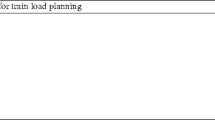Abstract
The present paper faces the train load planning problem in container terminals. The problem consists of assigning containers to rail wagons while maximizing the total priority of the containers loaded and minimizing the number of rehandles executed in the terminal yard. Two different heuristic approaches, based on an innovative way to compute weight limitations and on two 0/1 integer programming models, are proposed and compared on the basis of specific key performance indicators. The heuristic approaches are compared using random generated instances based on real-world data. An extensive computational analysis has been performed.











Similar content being viewed by others
References
Ahuja RK, Cunha CB, Sahin G (2005) Network models in railroad planning and scheduling tutorials. Oper Res. https://doi.org/10.1287/educ.1053.0013
Alumur SA, Kara BY, Karasan OE (2012) Multimodal hub location and hub network design. Omega 40:927–939
Ambrosino D, Siri S (2015) Comparison of solution approaches for the train load planning problem in seaport terminals. Transp Res Part E 79:65–82
Ambrosino D, Bramardi A, Pucciano M, Sacone S, Siri S (2011) Modeling and solving the train load planning problem in seaport container terminals. In: Proceedings of CASE’11, pp 208–213
Ambrosino D, Caballini C, Siri S (2013) A mathematical model to evaluate different train loading and stacking policies in a container terminal. Marit Econ Logist 15:292–308
Ambrosino D, Bernocchi L, Siri S (2016) Multi-objective optimization for the train load planning problem with two cranes in seaport terminals. In: IFAC-PapersOnLine, vol 9, pp 383–388
Anghinolfi D, Paolucci M (2014) A general purpose Lagrangian heuristic applied to the train loading problem. Procedia Soc Behav Sci 108:37–46
Anghinolfi D, Paolucci M, Sacone S, Siri S (2011) Freight transportation in railway networks with automated terminals: a mathematical model and MIP heuristic approaches. Eur J Oper Res 214:588–594
Bektas T, Crainic TG, Morency V (2009) Improving the performance of rail yards through dynamic reassignments of empty cars. Transp Res Part C 17:259–273
Bostel N, Dejax P (1998) Models and algorithms for container allocation problems on trains in a rapid transshipment shunting yard. Transp Sci 32:370–379
Bruns F, Knust S (2012) Optimized load planning of trains in intermodal transportation. OR Spectr 34:511–533
Bruns F, Goerigk M, Knust S (2014) Robust load planning of trains in intermodal transportation. OR Spectr 36:631–668
Corry P, Kozan E (2006) An assignment model for dynamic load planning of intermodal trains. Comput Oper Res 32:1–17
Corry P, Kozan E (2008) Optimised loading patterns for intermodal trains. OR Spectr 30:721–750
Kozan E (1997) Increasing the operational efficiency in Australia. J Oper Res Soc 48:151–161
Lai YC, Barkan CPL, Onal H (2012) Optimizing the aerodynamic efficiency of intermodal freight trains. Transp Res Part E 44:820–834
Luan X, Miao J, Meng L, Corman F, Lodewijks G (2017) Integrated optimization on train scheduling and preventive maintenance time slots planning. Transp Res Part C 80:329–359
Mantovani S, Morganti G, Umang N, Crainic TG, Frejinger E, Larsen E (2018) The load planning problem for double-stack intermodal trains. Eur J Oper Res 267(1):107–119
Parola F, Sciomachen A (2009) Modal split evaluation of a maritime container terminal. Marit Econ Logist 11:77–97
Rodriguez-Molins M, Salido MA, Barber F (2012) Intelligent planning for allocating containers in maritime terminals. Expert Syst Appl 39:978–989
Stahlbock R, Voss S (2008) Operations research at container terminals: a literature update. OR Spectr 30:1–52
Steenken D, Voss S, Stahlbock R (2004) Container terminal operation and operations research—a classification and literature review. OR Spectr 26:3–49
Tierney K, Vo S, Stahlbock R (2014) A mathematical model of inter-terminal transportation. Eur J Oper Res 235:448–460
Trenitalia M (2006) Increasing the operational efficiency in Australia. Divisione Cargo-Programmazione e Gestione Carri. Parco Rotabili
Vaidyanathan B, Ahuja RK, Liu J, Shughart LA (2008) Real-life locomotive planning: new formulations and computational results. Transp Res Part B 42:147–168
Vis FA, de Koster R (2003) Transshipment of containers at a container terminal: an overview. Eur J Oper Res 147:1–16
Wanga WF, Yun WY (2013) Scheduling for inland container truck and train transportation. Int J Prod Econ 143:349–356
Woxenius J, Bergqvist R (2011) Comparing maritime containers and semi-trailers in the context of hinterland transport by rail. J Transp Geogr 19:680–688
Acknowledgements
The authors would like to thank Francesco Schiariti from Trenitalia Cargo S.p.a. (the main Italian railway operator) for his useful support and data provided to validate the results obtained in this research, the Italian container terminals for their useful information and data, and Davide Anghinolfi from the DIBRIS Department of the University of Genova for his C\(\sharp\) libraries.
Author information
Authors and Affiliations
Corresponding author
Appendix 1. The lever principles
Appendix 1. The lever principles
Stability conditions are derived from lever principles, which state that two unequal forces, when acting in opposite directions, arrive at an equilibrium when the product of the magnitude of a generic force \(\overrightarrow{F_1}\) and its lever arm \(e_1\) (the distance of its point of application from the fulcrum), is equal to the product of the magnitude of a second force \(\overrightarrow{F_2}\) with its corresponding lever arm \(e_2\) (\(\overrightarrow{F_1} \cdot e_1=\overrightarrow{F_2} \cdot e_2\)). Note that a bogie—also called railroad truck or wheel truck—represents a structure underneath a train to which axles (and, hence, wheels) are attached through bearings.
To better clarify lever principles, refer to Fig. 12, levers of containers \(c_1\) and \(c_2\) (\(e_1\) and \(e_2\), respectively) are determined as the distance between their center of gravity—which should be in the middle of the container—and the attachment of one of the two bogies (note that containers’ levers are calculated in reference to the same bogie). Moreover, the distance (d) between bogies is known; finally, it is assumed that the tare mass of the wagon is equally distributed on the two wagon bogies.
Rights and permissions
About this article
Cite this article
Ambrosino, D., Caballini, C. New solution approaches for the train load planning problem. EURO J Transp Logist 8, 299–325 (2019). https://doi.org/10.1007/s13676-018-0127-x
Received:
Accepted:
Published:
Issue Date:
DOI: https://doi.org/10.1007/s13676-018-0127-x





